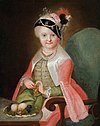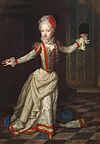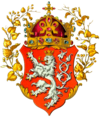Joseph I, Holy Roman Emperor
| Joseph I | |
|---|---|
 Portrait by Frans van Stampart, c. 1705 | |
| Holy Roman Emperor | |
| Reign | 5 May 1705 – 17 April 1711 |
| Predecessor | Leopold I |
| Successor | Charles VI |
| Born | 26 July 1678 Vienna, Archduchy of Austria, Holy Roman Empire |
| Died | 17 April 1711 (aged 32) Vienna, Archduchy of Austria, Holy Roman Empire |
| Burial | Imperial Crypt, Vienna |
| Spouse | |
Roman Catholicism | |
| Signature |  |
Joseph I (Joseph Jacob Ignaz Johann Anton Eustachius; 26 July 1678 – 17 April 1711) was
Joseph continued the
His motto was Amore et Timore (Latin for "Through Love and Fear").[2]
Early life

Born in Vienna, Joseph was educated strictly by Charles Theodore, Prince of Salm, and became a good linguist. Perhaps due to the influence of his formerly Protestant tutor he was a less devout Catholic than his parents and other relatives and developed into an adherent of the early Age of Enlightenment.[3] He had two great enthusiasms: music and hunting.[3]
Although Joseph was the first son and child born of his parents' marriage, he was his father's third son and seventh child. Previously, Leopold had been married to Infanta Margaret Theresa of Spain, who had given him four children, one of whom survived infancy. He then married Claudia Felicitas of Austria, who gave him two short-lived daughters. Thus, Joseph had six half-siblings. In 1684, the six-year-old Archduke had his first portrait painted by Benjamin Block. At the age of nine, on 9 December 1687, he was crowned King of Hungary; and at the age of eleven, on 23 January 1690, King of the Romans.
Military service
In 1702, at the outbreak of the War of the Spanish Succession, Joseph saw his only military service. He joined the Imperial General, Louis William, Margrave of Baden-Baden, in the Siege of Landau.
Holy Roman Emperor

Prior to his ascension, Joseph had surrounded himself with reform-hungry advisors and the young court of Vienna was ambitious in the elaboration of innovative plans. He was described as a "forward-looking ruler".[3] The large number of privy councillors was reduced and attempts were made to make the bureaucracy more efficient. Measures were taken to modernize the central bodies and a certain success was achieved in stabilizing the chronically poor Habsburg finances. Joseph also endeavoured to strengthen his position in the Holy Roman Empire – as a means of strengthening Austria’s standing as a great power. When he sought to lay claim to imperial rights in Italy and gain territories for the Habsburgs, he even risked a military conflict with the Pope over the Duchy of Mantua.[3] Joseph I was threatened with excommunication by Pope Clement XI on 16 June 1699.[4]
In Hungary, Joseph had inherited the
Death
During the smallpox epidemic of 1711, which killed Louis, Grand Dauphin and three siblings of the future Emperor Francis I, Joseph became infected. He died on 17 April in the Hofburg palace. He had previously promised his wife to stop having affairs, should he survive.
The Emperor was buried in the
Marriage and lack of heirs
On 24 February 1699, he married
Issue
| Name | Portrait | Lifespan | Notes |
|---|---|---|---|
| Maria Josepha Queen of Poland |

|
8 December 1699 – 17 November 1757 |
Archduchess of Austria, married Augustus III , King of Poland and Elector of Saxony.
|
| Leopold Joseph |
29 October 1700 – 4 August 1701 |
Archduke of Austria, died in infancy. | |
| Maria Amalia Holy Roman Empress |

|
22 October 1701 – 11 December 1756 |
Archduchess of Austria, married Charles VII, Holy Roman Emperor |
Ancestors
| Ancestors of Joseph I, Holy Roman Emperor | |||||||||||||||||||||||||||||||||||||||||||||||||||||||||||||||||||||||||||||||||||||||||||||||||||||||||||||||||||||||||||||||||||||||||||||||||||||||||||||||||||||||||||||||||||||||||||||||||||||||||||||||||||||||||||||||||||||||||||||||||||||||||
|---|---|---|---|---|---|---|---|---|---|---|---|---|---|---|---|---|---|---|---|---|---|---|---|---|---|---|---|---|---|---|---|---|---|---|---|---|---|---|---|---|---|---|---|---|---|---|---|---|---|---|---|---|---|---|---|---|---|---|---|---|---|---|---|---|---|---|---|---|---|---|---|---|---|---|---|---|---|---|---|---|---|---|---|---|---|---|---|---|---|---|---|---|---|---|---|---|---|---|---|---|---|---|---|---|---|---|---|---|---|---|---|---|---|---|---|---|---|---|---|---|---|---|---|---|---|---|---|---|---|---|---|---|---|---|---|---|---|---|---|---|---|---|---|---|---|---|---|---|---|---|---|---|---|---|---|---|---|---|---|---|---|---|---|---|---|---|---|---|---|---|---|---|---|---|---|---|---|---|---|---|---|---|---|---|---|---|---|---|---|---|---|---|---|---|---|---|---|---|---|---|---|---|---|---|---|---|---|---|---|---|---|---|---|---|---|---|---|---|---|---|---|---|---|---|---|---|---|---|---|---|---|---|---|---|---|---|---|---|---|---|---|---|---|---|---|---|---|---|---|
| |||||||||||||||||||||||||||||||||||||||||||||||||||||||||||||||||||||||||||||||||||||||||||||||||||||||||||||||||||||||||||||||||||||||||||||||||||||||||||||||||||||||||||||||||||||||||||||||||||||||||||||||||||||||||||||||||||||||||||||||||||||||||
Male-line family tree
References
- ^ Johann Burkhard Mencke; Leben und Thaten Sr. Majestät des Römischen Käysers Leopold des Ersten pg 914 https://books.google.com/books?id=AdhXAAAAcAAJ&q=Josephus+Jacobus+Ignatius+Johannes+Antonius+Eustachius&pg=PA914
- ^ "Joseph I as Roman-German Emperor, oval portrait with motto". The World of the Habsburgs. english.habsburger.net. Archived from the original on July 10, 2012. Retrieved February 18, 2012.
- ^ a b c d e f "Reforming zeal in the Baroque: Joseph I". The World of the Habsburgs. english.habsburger.net. Archived from the original on December 14, 2011. Retrieved February 18, 2012.
- ^ Joaquín Lorenzo Villanueva, Misapprehension of Patrick Curties and James Doyle concerning the oath which the bishops of Ireland take to the Roman Pontiff, (1825) page 64
- ISBN 0-312-08691-1p.XI p.36-37
- ^ a b c d Genealogie ascendante jusqu'au quatrieme degre inclusivement de tous les Rois et Princes de maisons souveraines de l'Europe actuellement vivans [Genealogy up to the fourth degree inclusive of all the Kings and Princes of sovereign houses of Europe currently living] (in French). Bourdeaux: Frederic Guillaume Birnstiel. 1768. p. 100.
- ^ a b Eder, Karl (1961), "Ferdinand III.", Neue Deutsche Biographie (in German), vol. 5, Berlin: Duncker & Humblot, pp. 85–86; (full text online)
- ^ Wurzbach, Constantin von, ed. (1861). . Biographisches Lexikon des Kaiserthums Oesterreich [Biographical Encyclopedia of the Austrian Empire] (in German). Vol. 7. p. 23 – via Wikisource.
- ^ a b Fuchs, Peter (2001), "Philipp Wilhelm", Neue Deutsche Biographie (in German), vol. 20, Berlin: Duncker & Humblot, p. 384; (full text online)
- ^ a b Louda, Jirí; MacLagan, Michael (1999). Lines of Succession: Heraldry of the Royal Families of Europe (2nd ed.). London: Little, Brown and Company. table 84.
- This article incorporates text from a publication now in the public domain: Chisholm, Hugh, ed. (1911). "Joseph I". Encyclopædia Britannica. Vol. 15 (11th ed.). Cambridge University Press. p. 514.
Bibliography
- C. W. Ingrao, In Quest and Crisis: Emperor Joseph I and the Habsburg Monarchy (1979)
- F. Krones von Marchiand, Grundriss der Oesterreichischen Geschichte (1882)
- F. Wagner, Historia Josephi Caesaris (1746)
- J. C. Herchenhahn, Geschichte der Regierung Kaiser Josephs I (1786–1789)
- C. van Noorden, Europäische Geschichte im achtzehnten Jahrhundert (1870–1882).
External links
![]() Media related to Joseph I, Holy Roman Emperor at Wikimedia Commons
Media related to Joseph I, Holy Roman Emperor at Wikimedia Commons
- Joseph I in the German National Library catalogue
- Joseph I.: "Regina coeli"
- Joseph I (Holy Roman Empire) - MSN Encarta (Archived 2009-10-31)[1]


